


This site is made possible by member support. 💞
Big thanks to Arcustech for hosting the site and offering amazing tech support.
When you buy through links on kottke.org, I may earn an affiliate commission. Thanks for supporting the site!
kottke.org. home of fine hypertext products since 1998.
Entries for April 2015
Netflix orders Green Eggs and Ham
Netflix is making a 13-episode animated adaptation of Dr. Seuss’ Green Eggs and Ham. The show will premiere in 2018 and the official press release shows that Netflix is fully committed to the premise:
Issued from Netflix headquarters.
Delivered straight to all reporters.We’d love to share some happy news
based on the rhymes of Dr. Seuss.
Green Eggs and Ham will become a show
and you’re among the first to know.In this richly animated production,
a 13-episode introduction,
standoffish inventor (Guy, by name)
and Sam-I-Am of worldwide fame,
embark on a cross-country trip
that tests the limits of their friendship.
As they learn to try new things,
they find out what adventure brings.
Of course they also get to eat
that famous green and tasty treat!Cindy Holland, VP of Original Content for Netflix
threw her quote into the mix:
“We think this will be a hit
Green Eggs and Ham is a perfect fit
for our growing slate of amazing stories
available exclusively in all Netflix territories.
You can stream it on a phone.
You can stream it on your own.
You can stream it on TV.
You can stream it globally.”
For reference, here’s an animated version of Green Eggs and Ham done in the 70s:
The Apollo lunar rover user’s manual




From NASA, the operations manual for the lunar rover. Rovers were used on the final three Apollo missions: 15, 16, and 17. (thx, daniel)
Old Katmandu
From Kevin Kelly, a collection of photos he took of Katmandu, Nepal in 1976.

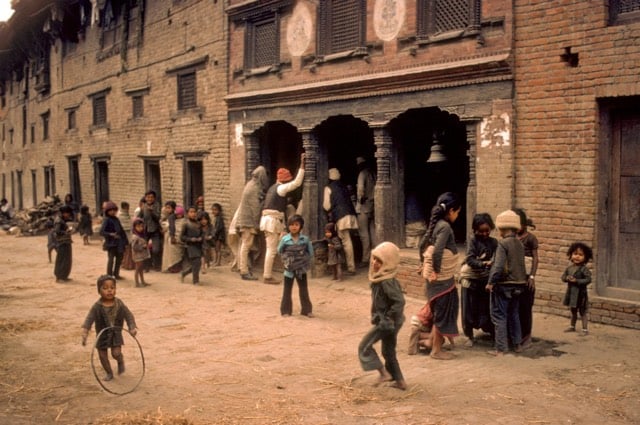

Nepal was recently affected by a 7.8 earthquake, which resulted in the deaths of more than 6000 people and much property damage.
Katmandu was an intensely ornate city that is easily damaged. The carvings, details, public spaces were glorious. My heart goes out to its citizens who suffer with their city. As you can see from these images I took in 1976, the medieval town has been delicate for decades. Loosely stacked bricks are everywhere. One can also see what splendid art has been lost. Not all has been destroyed, and I am sure the Nepalis will rebuild as they have in the past. Still, the earthquake shook more than just buildings.
If you look carefully you may notice something unusual about these photos. They show no cars, pedicabs, or even bicycles. At the time I took these images, Katmandu was an entirely pedestrian city. Everyone walked everywhere. Part of why I loved it. That has not been true for decades, so this is something else that was lost long ago. Also missing back then was signage. There are few signs for stores, or the typical wordage you would see in any urban landscape today. Katmandu today is much more modern, much more livable, or at least it was.
All movie trailers are the same
The other day, I made a reference to a trailer for a TV series being “a little too trailery for my taste”. What I meant was that it too much like every other trailer (in that genre) and didn’t show enough of the character of the particular show being advertised. Action movie trailers are perhaps the worse offenders in this regard, as this meta-trailer shows:
BWAAAAAAAAM!!!
Build up to silence, then BAM!
Like I was saying, too trailery. (via devour)
Great interview by Om Malik of Brunello Cucinelli. Lots of gems about working and attention.
The trolley problem
The trolley problem is an ethical and psychological thought experiment. In its most basic formulation, you’re the driver of a runaway trolley about to hit and certainly kill five people on the track ahead, but you have the option of switching to a second track at the last minute, killing only a single person. What do you do?
The problem becomes stickier as you consider variations of the problem:
As before, a trolley is hurtling down a track towards five people. You are on a bridge under which it will pass, and you can stop it by putting something very heavy in front of it. As it happens, there is a very fat man next to you — your only way to stop the trolley is to push him over the bridge and onto the track, killing him to save five. Should you proceed?
As driverless cars and other autonomous machines are increasingly on our minds, so too is the trolley problem. How will we program our driverless cars to react in situations where there is no choice to avoid harming someone? Would we want the car to run over a small child instead of a group of five adults? How about choosing between a woman pushing a stroller and three elderly men? Do you want your car to kill you (by hitting a tree at 65mph) instead of hitting and killing someone else? No? How many people would it take before you’d want your car to sacrifice you instead? Two? Six? Twenty? Is there a place in the car’s system preferences panel to set the number of people? Where do we draw those lines and who gets to decide? Google? Tesla? Uber?1 Congress? Captain Kirk?
If that all seems like a bit too much to ponder, Kyle York shared some lesser-known trolley problem variations at McSweeney’s to lighten the mood.
There’s an out of control trolley speeding towards a worker. You have the ability to pull a lever and change the trolley’s path so it hits a different worker. The first worker has an intended suicide note in his back pocket but it’s in the handwriting of the second worker. The second worker wears a T-shirt that says PLEASE HIT ME WITH A TROLLEY, but the shirt is borrowed from the first worker.
Reeeeally makes you think, huh?
If Uber gets to decide, the trolley problem’s ethical concerns vanish. The car would simply hit whomever will spend less on Uber rides and deliveries in the future, weighted slightly for passenger rating. Of course, customers with a current subscription to Uber Safeguard would be given preference at different coverage levels of 1, 5, and 20+ ATPs (Alternately Targeted Persons).↩
Letterman prepares to sign off
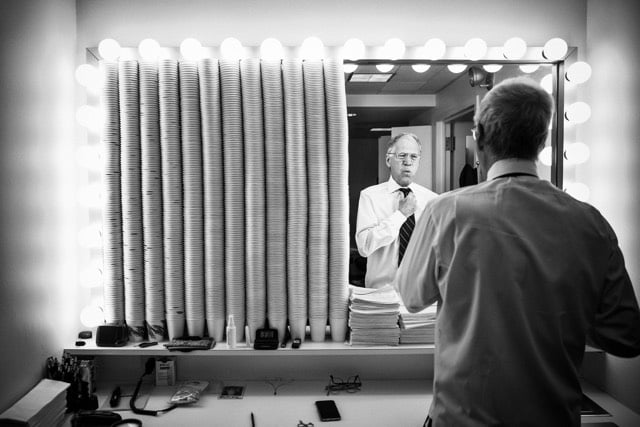
I was never a particular fan of David Letterman’s show1 but always have appreciated what he did and how he did it. Dave Itzkoff of the NY Times did an interview with Letterman about his impending retirement.
It seems like there’s an increasing emphasis, at least with your network competitors, to create comedy bits that will go viral on the Internet. Did you make a conscious choice to stay out of that arms race?
No, it just came and went without me. It sneaked up on me and went right by. People on the staff said, “You know what would be great is if you would join Twitter.” And I recognized the value of it. It’s just, I didn’t know what to say. You go back to your parents’ house, and they still have the rotary phone. It’s a little like that.
The photo slide show accompanying the piece is worth a look as well, particularly the photo of the stack of paper coffee cups in Letterman’s dressing room (one cup for each show, they cover half his mirror) and the final one of Letterman bounding out onto stage. I hope that when I’m 68, I’m still charging ahead like Dave.
To be honest, I’ve never been a particular fan of any late night television, save for SNL in the late 80s and early 90s. I watched the last few years of Johnny Carson on The Tonight Show and then the first couple years of Leno, mostly because that’s what my parents watched. Letterman I caught every once in awhile after Carson and rarely after his move to CBS. I’ve only seen Conan’s show a handful of times…same with The Daily Show and Colbert. Have never watched a single episode of Fallon or Kimmel or Conan’s new show. Oh, I’ve seen clips on the web and such, but never whole shows.
My late night TV as a kid was Doctor Who and British comedies — Are You Being Served?, ‘Allo ‘Allo, Fawlty Towers, Good Neighbors, Keeping Up Appearances, The Fall And Rise Of Reginald Perrin, etc. — on the local PBS station. That and Nintendo.↩
Jonathan Strange and Mr. Norrell, the TV series
Ever since I read Susanna Clarke’s Jonathan Strange & Mr. Norrell just after it came out, I’ve wondered when someone was going to do a movie or miniseries adaptation. Well, BBC has stepped up with a seven-part series that debuts on BBC One in May and on BBC America “this summer”. Here’s a trailer:
Set at the beginning of the 19th-century, England no longer believes in practical magic. The reclusive Mr Norrell of Hurtfew Abbey stuns the city of York when he causes the statues of York Cathedral to speak and move. With a little persuasion and help from his man of business Childermass, he goes to London to help the government in the war against Napoleon. It is there Norrell summons a fairy to bring Lady Pole back from the dead, opening a whole can of worms…
That trailer was a little too trailery for my taste (if you know what I mean), but I’m excited nonetheless. (via ★interesting)
Update: BBC America has put the first episode of the show up on YouTube:
The rest of the episodes are available in a slightly less official capacity as well — here’s episode 2 for instance.
Freddie Gray and unrest in Baltimore
After a night of riots in Baltimore, schools are closed, games have been postponed, at least a thousand National Guard soldiers are roaming the streets, and America is left once again to ponder issues of race, inequality, law enforcement, and civic unrest.
InFocus: Images of unrest in Baltimore.
WaPo’s Michael A. Fletcher on the murder, drugs, and poverty that plague Freddie Gray’s Baltimore:
Most of these problems are confined to the pockmarked neighborhoods of narrow rowhomes and public housing projects on the city’s east and west sides. They exist in the lives of the other Baltimore of renovated waterfront homes, tree-lined streets, sparkling waterfront views, rollicking bars and ethnic restaurants mainly through news reports. The two worlds bump up against one another only on occasion.
Vox: In Freddie Gray’s Baltimore neighborhood, half of the residents don’t have jobs.
Last night my mom wondered aloud why we still don’t seem to know many of the details when it comes to Gray’s death. Well mom, the answer is LEOBoR, or the law enforcement officers bill of rights. From The Marshall Project: Blue Shield.
The backwards bike will break your brain
Do you think you could ride a bicycle that steers backwards…aka it turns left when you turn right and vice versa? It sounds easy but years of normal bike riding experience makes it almost impossible. Destin Sandlin of Smarter Everyday taught himself how to ride the backwards-steering bike; it took months. Then he tried riding a normal bicycle again…
Loved this video…great stuff. (via ★interesting)
Jamie Oliver: how to chop an onion
Chef and TV personality Jamie Oliver shows three different techniques for chopping onions, including the dead simple “crystals” method.
A Tour of Antarctica by Drone
This 8-minute video of a drone’s eye tour of the coast of Antarctica is just flat-out gorgeous.
40 years of the American home

In 1973, the year I was born, the median new single-family house in the US measured 1525 sq feet. It had two floors, three bedrooms, and two bathrooms. In 2013, the median new single-family house in the US is 56% larger (2385 sq ft) and contains an extra half-bath. You can watch the evolution of the American home at CNN.
Black Mass trailer
Black Mass stars Johnny Depp as Whitey Bulger, real-life Boston mobster and FBI informant. The trailer is damn good and I’m hoping the rest of the movie lives up to it.
The surprisingly complex design of the Ziploc bag. Big props to the Ziploc folks, generic resealable bags suck
The Hubble Space Telescope turns 25
The Hubble Space Telescope was deployed into space on April 25, 1990 and began snapping images of the sky shortly thereafter. Phil Plait, the NY Times, NPR, and How We Get To Next have chosen some of their favorite Hubble images, and Taschen published a coffee table book of Hubble images called Expanding Universe.





I still find it incredible that we have a telescope orbiting the Earth. Happy birthday, Hubble. Here’s to many more.
The full-sized Lego car
Raul Oaida built a full-sized car out of half-a-million Lego pieces that actually drives. The 256-cylinder engine is powered by compressed air. Top speed is 20 mph.
This is a stunning and insanely clever achievement. My favorite part, aside from that 256-cylinder engine, is the windshield built out of two dozen tiny Lego windshields. (via devour)
Dooce is retiring
After many years of blogging professionally at Dooce, Heather Armstrong is stepping down to focus on speaking and brand consultation. She’s planning to write for fun again.
But what makes this livelihood glaringly different are not only the constant creative strains of churning out new and entertaining content — content we cannot delegate to anyone else because our audiences read our stories for our particular voice and perspective — but also the security systems we’ve had to set up as an increasingly more diverse group of people throw rocks at our houses with the intention of causing damage: passersby, rubbernecks, stalkers, even journalists. We have separate security systems for those who take every word and decision we share and deliberately misinterpret it, disfigure it to the point of it being wholly unrecognizable, and then broadcast to us and to their own audiences that they have diagnosed us with a personality disorder.
“Living online” for us looks completely different now than it did when we all set out to build this community, and the emotional and physical toll of it is rapidly becoming a health hazard.
There’s a lot in what Heather wrote that resonates with me. (See also Amateur Gourmet, Dylan Byers, and Marco Arment.) Two or three years ago, I thought I would do my site professionally for the rest of my life, or at least a good long while. The way things are going, in another year or two, I’m not sure that’s even going to be an option. The short window of time in which individuals could support themselves by blogging is closing rapidly. There’s a lot more I could say about that, but for now, I’ll offer my best wishes to Heather in her new endeavors. Dooce is dead, long live Dooce.
The Glass Is Already Broken
“You see this goblet?” asks Achaan Chaa, the Thai meditation master. “For me this glass is already broken. I enjoy it; I drink out of it. It holds my water admirably, sometimes even reflecting the sun in beautiful patterns. If I should tap it, it has a lovely ring to it. But when I put this glass on the shelf and the wind knocks it over or my elbow brushes it off the table and it falls to the ground and shatters, I say, ‘Of course.’ When I understand that the glass is already broken, every moment with it is precious.”
From Thoughts Without a Thinker: Psychotherapy from a Buddhist Perspective by Mark Epstein.
This baby’s butt is a cash machine
I don’t know what this is, who made it, or why, but it is the perfect Friday thing. (via @triciawang)
Update: Alright, the readers have spoken and they hate the baby ATM. So I unembedded the video clip. If you want to have a laugh or be appalled, you can click through.
An animated history of 20th century hairstyles
From The Atlantic, a history of hairstyles from 1900 to the present.
Hairstyles featured include the Gibson Girl, bob, conk, pompadour, beehive, Jheri curl, and hi-top fade.
1491, the TV series
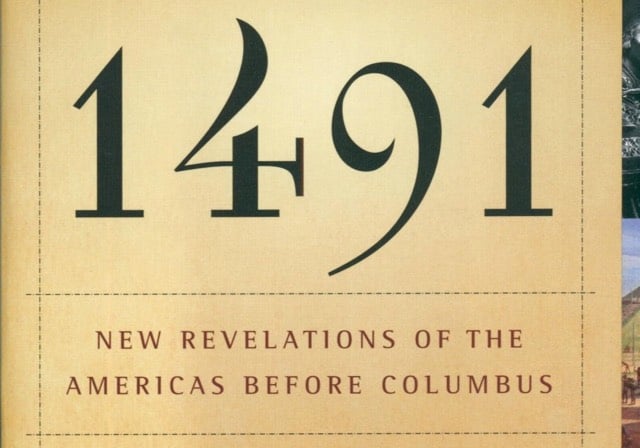
Charles Mann’s 1491 is one of my all-time favorite books. I mean, if this description doesn’t stir you:
Contrary to what so many Americans learn in school, the pre-Columbian Indians were not sparsely settled in a pristine wilderness; rather, there were huge numbers of Indians who actively molded and influenced the land around them. The astonishing Aztec capital of Tenochtitlan had running water and immaculately clean streets, and was larger than any contemporary European city. Mexican cultures created corn in a specialized breeding process that it has been called man’s first feat of genetic engineering. Indeed, Indians were not living lightly on the land but were landscaping and manipulating their world in ways that we are only now beginning to understand. Challenging and surprising, this a transformative new look at a rich and fascinating world we only thought we knew.
On Twitter yesterday, Mann shared that a documentary series was being made based on the book. The eight-part series is being commissioned by Canada’s APTN (Aboriginal Peoples Television Network) and Barbara Hager, who is of Cree/Metis heritage, will write, direct, and produce.
This is fantastic news. I hope this gets US distribution at some point, even if it’s online-only.
How the sausage gets made
As the old saying goes, it is sometimes unpleasant to watch the sausage being made. But not as unpleasant as watching the olive loaf being made.
(via digg)
The Rites of Spring
WQXR took 46 performances of a selection of Igor Stravinsky’s The Rite of Spring and spliced them together into one piece, highlighting the how varied the performance of the notes on the page can be.
Finding Zero
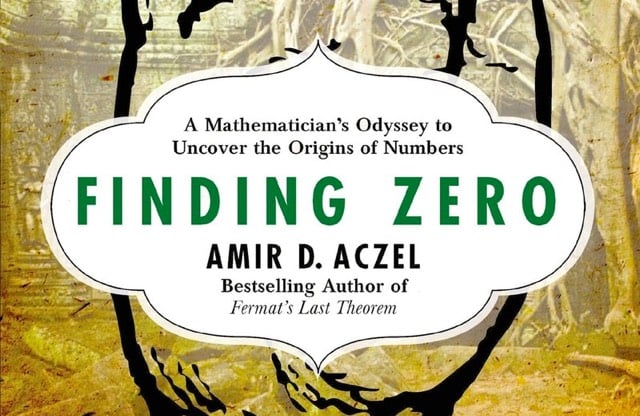
The latest book from Amir Aczel, who has written previously about the compass, the Large Hadron Collider, and Fermat’s Last Theorem, is Finding Zero: A Mathematician’s Odyssey to Uncover the Origins of Numbers…in particular, the number zero.
Finding Zero is an adventure filled saga of Amir Aczel’s lifelong obsession: to find the original sources of our numerals. Aczel has doggedly crisscrossed the ancient world, scouring dusty, moldy texts, cross examining so-called scholars who offered wildly differing sets of facts, and ultimately penetrating deep into a Cambodian jungle to find a definitive proof.
The NY Times has a review of the book, written by another Amir, Amir Alexander, who wrote a recent book on infinitesimals, aka very nearly zero. (via @pomeranian99)
The women of Don Draper
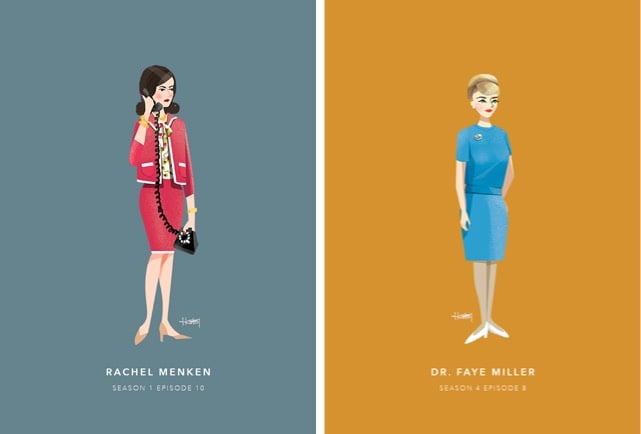
Hannah Choi is making illustrations of all the women Don Draper has slept with on Mad Men in chronological order.
4K dreamtime
Technically, what you’re looking at here is a video shot in 4K resolution (basically 2x regular HD) and at 1000 frames/sec by a Phantom Flex 4K camera which retails for $100,000+. Skateboarders ollie. Dirt bikes spray dirt. Gymnasts contort. Make this as fullscreen as possible and just sit back and enjoy.
My favorite bits were of the gymnasts. In super slow motion, you can see how aerial flips are all about getting your head down as quickly as possible, then snapping your legs around as your head stays almost completely motionless — like a chicken’s! Mesmerizing.
Treasure Trove of Over 1700 Mechanical Animations
Whenever I watch videos of how things are made, I marvel at the cleverness of the manufacturing machines. Retired engineer Duc Thang Nguyen has created over 1700 3D animations showing how all sorts of different mechanisms work…gears, linkages, drives, clutches, and couplings. Here are a few examples to whet your appetite.
(via make)
An oral history of Mad Men. “I sat down and wrote all seven seasons of Mad Men in about four hours.”
Desire map of the world
This map was compiled using the autocomplete results for “how much does a * cost” for every country in the world.
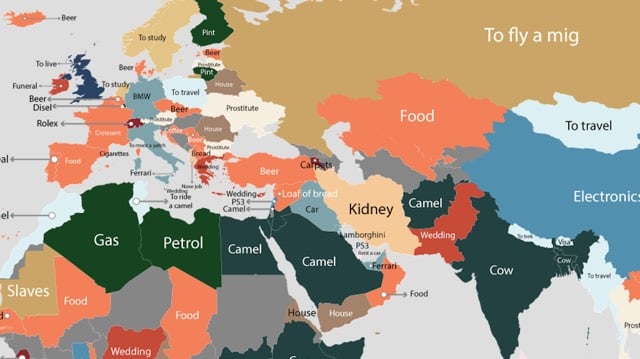
Some notable desires: Mexican tummy tucks, Brazilian prostitutes, Albanian nose jobs, Russian MiGs, Lebanese PS3s, and Japanese watermelons.
See also the desire map of the US.
America’s 1.5 million missing black men

In Ferguson, for every 100 black women between the ages of 25 and 54, there are 60 black men. While Ferguson is extreme, it’s not exceptional. Across America, we see similar numbers. So the question arises: What happened to all the black men? The short answer to that question is incarceration and premature death. The longer answer is equally upsetting. From Upshot: 1.5 Million Missing Black Men.
One-way streets are bad
A study of one-way streets in Louisville suggests they are generally not good for the city.
In 2011, Louisville converted two one-way streets near downtown, each a little more than a mile long, back to two-way traffic. In data that they gathered over the following three years, Gilderbloom and William Riggs found that traffic collisions dropped steeply — by 36 percent on one street and 60 percent on the other — after the conversion, even as the number of cars traveling these roads increased. Crime dropped too, by about a quarter, as crime in the rest of the city was rising. Property values rose, as did business revenue and pedestrian traffic, relative to before the change and to a pair of nearby comparison streets. The city, as a result, now stands to collect higher property tax revenues along these streets, and to spend less sending first-responders to accidents there.
For decades, American cities have been built around the automobile and getting them and their passengers through cities as quickly as possible. This research suggests slowing the pace of the city results in increased safety, decreased crime, and higher property values. (via mr)
Update: More evidence from Tampa, Denver, and Richmond that one-way streets aren’t the best. (via @techsavvywriter)
Huge study of 95,000 children confirms no link between MMR vaccination & autism. Scientists: “well, duh.”
Tomorrowland trailer
Ok, even though George Clooney’s character says “you ain’t seen nothing yet” in the trailer, I am cautiously optimistic that Tomorrowland won’t actually suck. Brad Bird is directing, for one thing.
Interesting thing about Clooney: even though he’s one of the biggest movie stars in the world, aside from Gravity, he’s never really had a big summer blockbustery sort of hit. Only six of his films have grossed more than $100 million…compare that with Will Smith or even Matt Damon, both of whom are younger.1 Perhaps Tomorrowland will be Clooney’s Pirates of the Caribbean or Bourne.
The list of actors sorted by box office gross is fascinating, btw. The top five: Tom Hanks, Morgan Freeman, Samuel L. Jackson, Harrison Ford, and Eddie Murphy, three of whom are black. The first woman on the list is Cameron Diaz at #13 (and then Cate Blanchett at 21, Helena Bonham Carter at 22, Emma Watson at 25, and Julia Roberts at 26). Sorting by average gross isn’t working for me, but I scanned through and found the top five (who have been in 6 or more films): Emma Watson (whose movies gross $191.6 million on average), Daniel Radcliffe, Taylor Lautner, Rupert Grint, and Liam Hemsworth. ↩
Amazon’s goat grazing services
Included in Amazon’s recently launched Home Services is a goat grazing service, currently in beta.
Q: If goat grazing is right for my property, what would the service entail?
A: Once a pro has met with you to determine if unleashing some friendly goats on your property will help you get rid of any unwanted vegetation, you’ll receive a recommendation for how many goats will be loaned to you, how long those goats will keep you company, and how often a pro will come check on them to make sure they’re not attempting any fancy tricks to break free from the temporary fencing that will be placed around them. As they graze, they will likely leave behind some droppings, too, and you’ll get to keep this fertilizer as a friendly parting gift!
The goat grazing service isn’t available in Manhattan, but Amazon really does want to sell everything in the world, don’t they. Buy N Large, here we come. (via @mkonnikova)
2015 Pulitzer Prize winners
Vox has a list of all the 2015 Pulitzer Prize winners. I am especially pleased to see Elizabeth Kolbert win the general nonfiction category for The Sixth Extinction: An Unnatural History…I’ve been reading her writing on climate change and environmental issues in the New Yorker for years now.
Philip Glass discusses his piano etudes
For the first episode of BAM’s new podcast, Philip Glass and several world-class pianists talk about Glass’s piano etudes and what makes them so challenging to perform.
Simple rules for healthy eating
From pediatrics professor Aaron Carroll, a list of guidelines for sensible & healthy eating.
1. Get as much of your nutrition as possible from a variety of completely unprocessed foods. These include fruits and vegetables. But they also include meat, fish, poultry and eggs that haven’t been processed. In other words, try to buy food that hasn’t been cooked, prepared or altered in any way. Brown rice over white rice. Whole grains over refined grains. You’re far better off eating two apples than drinking the same 27 grams of sugar in an eight-ounce glass of apple juice.
What’s more interesting than the guidelines is the admission up front that they’re not supported by rigorous science…and neither is nutrition in general. In the absence of science, “everything in moderation” seems to be the recommended course. (via @jimray)
Update: Julia Belluz recently interviewed Surgeon General1 Vivek Murthy for Vox and within, Murthy shares his four basic rules for health:
One is to eat healthy. I tend to avoid salt, added sugar, and processed foods whenever possible, and try to eat fresh fruits and vegetables as part of all my meals whenever possible.
Second is to stay physically active. That means not just going to gym but incorporating activity into whatever I do, whether that’s taking the stairs or converting sitting meetings to walking meetings whenever possible.
Third is making sure I’m focusing on my emotional and mental well-being. For me, an important part of that is the meditation practice that I do every morning. It’s a chance for me to center myself, a chance for me to remember who I want to be every day.
The fourth thing is I remind myself to stay away from toxic substances like tobacco and drugs.
What an odd antiquated governmental post, Surgeon General of the United States. The US government needs a robust advocate for the health of its citizens, but maybe not a 3-star admiral in the uniformed services you refer to as a surgeon? And while we’re on the topic, sort of, why not a Filmmaker Laureate, Musician Laureate, YouTube Star Laureate, TV Showrunner Laureate, iOS App Programmer Laureate, and Blogger Laureate in addition to Poet Laureate? ↩
Freeline skate tricks
I’d never heard of freeline skates before…they’re like little skateboards, one for each foot. This video shows how they’re used for tricks and such:
That looks hard, much more difficult than skateboarding or inline skates. But maybe not, once you get the hang of it? Can’t beat the portability though…they’d slip right into a small bag when you’re not using them. (via @matiasfrndz)
Make your own Star Wars BB-8 rolling ball droid
When the first trailer for JJ Abrams’ new Star Wars movie came out, we all assumed the rolling ball droid was CGI (and perhaps based on this 2008 xkcd post). Then an actual working model of the droid, called BB-8, showed up on stage at Star Wars Celebration. Minds blew. Industrial design student Christian Poulsen figured out how to make his own version of BB-8 by hacking a Sphero:
Update: It looks like Sphero will be manufacturing an official BB-8 droid toy, which will likely be a massive success.
Update: Sphero is selling a smartphone-controlled BB-8 droid. This is the droid you’re looking for.
Authentic Movement: Guide your BB-8 with a smartphone or tablet
Listens & Responds: BB-8 recognizes and reacts to your voice
Holographic Messaging: Record and view virtual holographic videos with BB-8
Autonomous Behavior: BB-8 has a mind of its own - explore the Star Wars galaxy together
Adaptive Personality: Your BB-8’s unique attitude and actions evolve as you interact
It’s also available at Amazon, although they are currently out of stock.
An interview with Slack’s CEO; Q. So do you think Slack is worth $3 billion? A. It is, because people say it is.
A history of the Cabbage Patch Kid craze
From Vice’s American Obsessions video series, a piece on the Cabbage Patch doll craze of the 1980s.
The idea for the Cabbage Patch doll was brazenly stolen from the original creator by Xavier Roberts, whose Wikipedia entry currently begins:
Xavier Roberts (born October 31, 1955, Cleveland, Georgia), misappropriater of Cabbage Patch Kids, is an American artist, businessman, thief and asshole.
His profile also states that he went on to create a series of bear toys called The Foreskin Bears. LOL. (via devour)
The Hateful Eight teaser trailer
This is the teaser trailer for Quentin Tarantino’s The Hateful Eight, the movie whose script leaked, was cancelled, was planned to be released as a book, and then uncanceled.
Update: I’m getting emails and tweets saying this trailer is fake. And if it is fake, is there a non-fake leaked trailer out there or…?
Update: Just to be clear, this is totally fake and constructed from bits of other movies, etc.
Jiro Ono and Rene Redzepi Have a Cup of Tea
Jiro Ono (who Dreams of Sushi) and René Redzepi (who is probably the current Best Chef in the World™) sit down for a cup of tea and a chat.
At one point, Redzepi asks Jiro at what age he thought he had become a master. The reply:
Let’s say it’s 50. There is a lot of failure before that. You go through failures and successes, and more failures for years until it feels like you have achieved what you had in mind the whole time.
There’s also a bit at the end, offered almost as an aside, of what it takes to be a master: a blend of stubbornness and sensitivity. What a combination…I wish they’d had another cup and talked about that.
The Making of Star Wars
In 1977, only a few months after the movie came out, a hour-long television special called The Making of Star Wars aired on ABC. It was the first documentary about Star Wars.
LOL to the rehearsal shot at 4:10 of Han going “bang, bang, bang, bang, bang” while shooting his blaster, the reaction of Luke, Han, and Leia to a boom mic blowing the 18th take of a scene at 34:20, and the description of Princess Leia as “royalty of a very liberated kind”. (via kung fu grippe)
Mad River Glen’s famed single chair
From Nowness, a brief homage to the single chair lift at one of the oddest and most wonderful ski areas in the US, Mad River Glen in Vermont.
You don’t have a lot of opportunity in life these days to have 10 or 12 minutes alone. Some people think when they come here and they ride the chair, it’s a lonely ride. I never really thought of it that way.
I haven’t checked for sure, but Mad River might be the only ski area in the world with a chairlift that has its own beer.
Update: Here’s what skiing in the trees in 16” of powder at Mad River Glen looks like.
Earliest Apple.com homepage
Kevin Fox recently unearthed a screenshot he took of Apple’s homepage in the early 90s:

I don’t remember this version, but it looks like it was contemporary with this Microsoft homepage (which I do remember). I bet there’s footage of this page in Triumph of the Nerds or Nerds 2.0.1 or on an episode of Computer Chronicles. Anyone?
FKA Biggie
Terry Urban’s 8-song mashup album of FKA Twigs and Notorious B.I.G.
Why not FKA Biggs? Or Notorious T.W.I.G.S.? Twiggie Smalls? (via @frank_chimero)
Star Wars: The Force Awakens teaser trailer #2
Ok, this one gave me goosebumps. I hope this is good.
MoMA’s digital art vault

Ben Fino-Radin of MoMA’s Department of Conservation wrote a brief post about how the museum manages their digital artworks, including a bit about how they think about futureproofing the collection.
The packager addresses the most fundamental challenge in digital preservation: all digital files are encoded. They require special tools in order to be understood as anything more than a pile of bits and bytes. Just as a VHS tape is useless without a VCR, a digital video file is useless without some kind of software that understands how to interpret and play it, or tell you something about its contents. At least with a VHS tape you can hold it in your hand and say, “Hey, this looks like a VHS tape and it probably has an analog video signal recorded on it.” But there is essentially nothing about a QuickTime .MOV file that says, “Hello, I am a video file! You should use this sort of software to view me.” We rely on specially designed software-be it an operating system or something more specialized-to tell us these things. The problem is that these tools may not always be around, or may not always understand all formats the way they do today. This means that even if we manage to keep a perfect copy of a video file for 100 years, no one may be able to understand that it’s a video file, let alone what to do with it. To avoid this scenario, the “packager” — free, open-source software called Archivematica — analyzes all digital collections materials as they arrive, and records the results in an obsolescence-proof text format that is packaged and stored with the materials themselves. We call this an “archival information package.”
Seveneves by Neal Stephenson
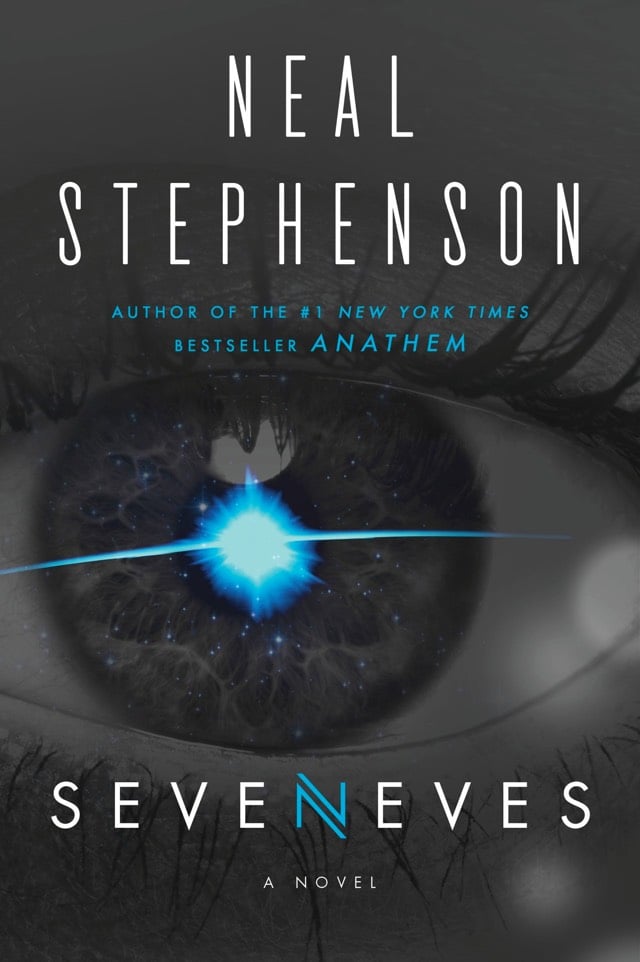
Neal Stephenson has made the first 26 pages of his upcoming book, Seveneves, available on his website. About the book:
A catastrophic event renders the earth a ticking time bomb. In a feverish race against the inevitable, nations around the globe band together to devise an ambitious plan to ensure the survival of humanity far beyond our atmosphere, in outer space.
But the complexities and unpredictability of human nature coupled with unforeseen challenges and dangers threaten the intrepid pioneers, until only a handful of survivors remain…
Five thousand years later, their progeny-seven distinct races now three billion strong-embark on yet another audacious journey into the unknown… to an alien world utterly transformed by cataclysm and time: Earth.
The novel is out on May 19.
Update: Seveneves is now out and getting some good reviews on Goodreads. Get it while it’s hot.
The monetary cost of gun violence in the US is $229 billion/yr. That’s $700/person a year.
The salad days of coin hunting
Roger Pasquier hunts for coins on NYC sidewalks and keeps track of how much he finds. He discovered an odd consequence of everyone having a smartphone: people don’t pick up change on the sidewalk anymore.
From 1987 to 2006, he averaged about fifty-eight dollars a year. Then Apple introduced the iPhone, and millions of potential competitors started to stare at their screens rather than at the sidewalks. Since 2007, Pasquier has averaged just over ninety-five dollars a year.
I know, I know, that’s anecdotal and correlation != causation and whatever, but that’s an interesting theory.
David Chase on The Sopranos ending

David Chase analyzes the final scene of The Sopranos in great detail for the Directors Guild of America’s quarterly magazine.
It was my decision to direct the episode such that whenever Tony arrives someplace, he would see himself. He would get to the place and he would look and see where he was going. He had a conversation with his sister that went like this. And then he later had a conversation with Junior that went like this. I had him walk into his own POV every time. So the order of the shots would be Tony close-up, Tony POV, hold on the POV, and then Tony walks into the POV. And I shortened the POV every time. So that by the time he got to Holsten’s, he wasn’t even walking toward it anymore. He came in, he saw himself sitting at the table, and the next thing you knew he was at the table.
Great read. Here’s the final scene to refresh your memory.
Ex Machina soundtrack
A new listen-while-you-code/write/design favorite.
I really liked the movie. Matt Zoller Seitz’s review captured it well.
Hillary Clinton logo typeface
Inspired by the logo for Hillary Clinton’s 2016 Presidential run, designer Rick Wolff created an entire uppercase alphabet for a typeface he’s calling Hillvetica.

From his Twitter stream, it appears that Wolff is attempting to make an actual Hillvetica font so stay tuned. FYI, Pentagram partner Michael Bierut designed the logo. The simplicity is appealing, but overall I am not a big fan of the arrowed H.
Update: The Washington Post made a little text editor so you can write whatever you want in Hillvetica. The Clinton campaign has already put it to use:
Putting Hillary Bold to good use. http://t.co/NVtjlsoH5u pic.twitter.com/M3Q3nsWqyV
— Hillary Clinton (@HillaryClinton) April 14, 2015The Ingenious Design of the Aluminum Beverage Can
The aluminum soda can is a humble testament to the power and scope of human ingenuity. If that sounds like hyperbole, you should watch this video, which features eleven solid minutes of engineering explanation and is not boring for even a second.
More science/engineering programming like this please…I feel like if this would have been on PBS or Discovery, it would have lasted twice as long and communicated half the information. For a chaser, you can watch a detailed making-of from an aluminum can manufacturing company:
Cognitive Cooking with Chef Watson

Watson, IBM’s evolving attempt at building a computer capable of AI, was originally constructed to excel at Jeopardy. Which it did, handily beating Jeopardy mega-champ Ken Jennings. Watson has since moved on to cooking and has just come out with a new cookbook, Cognitive Cooking with Chef Watson.
You don’t have to be a culinary genius to be a great cook. But when it comes to thinking outside the box, even the best chefs can be limited by their personal experiences, the tastes and flavor combinations they already know. That’s why IBM and the Institute of Culinary Education teamed up to develop a groundbreaking cognitive cooking technology that helps cooks everywhere discover and create delicious recipes, utilizing unusual ingredient combinations that man alone might never imagine.
In Cognitive Cooking with Chef Watson, IBM’s unprecedented technology and ICE’s culinary experts present more than 65 original recipes exploding with irresistible new flavors. Together, they have carefully crafted, evaluated and perfected each of these dishes for “pleasantness” (superb taste), “surprise” (innovativeness) and a “synergy” of mouthwatering ingredients that will delight any food lover.
HBO’s static intro
The electric snowstorm is joined by a single tone that ascends like a gospel choir singing to the heavens.
Playboy’s Zaron Burnett on HBO’s static intro, the most powerful force in the universe.
The Moral Bucket List
David Brooks asks: what does life look like when you stop focusing so much on resume building and external achievement and spend more time working on your morality and inner character?
It occurred to me that there were two sets of virtues, the résumé virtues and the eulogy virtues. The résumé virtues are the skills you bring to the marketplace. The eulogy virtues are the ones that are talked about at your funeral — whether you were kind, brave, honest or faithful. Were you capable of deep love?
We all know that the eulogy virtues are more important than the résumé ones. But our culture and our educational systems spend more time teaching the skills and strategies you need for career success than the qualities you need to radiate that sort of inner light. Many of us are clearer on how to build an external career than on how to build inner character.
But if you live for external achievement, years pass and the deepest parts of you go unexplored and unstructured. You lack a moral vocabulary. It is easy to slip into a self-satisfied moral mediocrity. You grade yourself on a forgiving curve. You figure as long as you are not obviously hurting anybody and people seem to like you, you must be O.K. But you live with an unconscious boredom, separated from the deepest meaning of life and the highest moral joys. Gradually, a humiliating gap opens between your actual self and your desired self, between you and those incandescent souls you sometimes meet.
This essay is adapted from Brooks’ newest book, The Road to Character, which is out tomorrow.
The Directors Series: Stanley Kubrick
From Cameron Beyl, a three-hour video essay on the films of Stanley Kubrick. The essay splits Kubrick’s career into five parts: the early independent features (Fear & Desire, Killer’s Kiss, The Killing), the Kirk Douglas years (Paths of Glory, Spartacus), the Peter Sellers comedies (Lolita, Dr. Strangelove), the Master Works (2001, A Clockwork Orange, Barry Lyndon, The Shining), and the final features (Full Metal Jacket, Eyes Wide Shut).
Beyl has just begun his second extended essay, on David Fincher. (via openculture)
The camera industry is shrinking, but thanks to smartphones, cameras are much more popular than ever
When to Rob a Bank…
A new book from the guys who brought you Freakonomics (which is ten years old…ten years): When to Rob a Bank: …And 131 More Warped Suggestions and Well-Intended Rants.
Over the past decade, Steven D. Levitt and Stephen J. Dubner have published more than 8,000 blog posts on Freakonomics.com. Many of them, they freely admit, were rubbish. But now they’ve gone through and picked the best of the best. You’ll discover what people lie about, and why; the best way to cut gun deaths; why it might be time for a sex tax; and, yes, when to rob a bank. (Short answer: never; the ROI is terrible.) You’ll also learn a great deal about Levitt and Dubner’s own quirks and passions, from gambling and golf to backgammon and the abolition of the penny.
FWIW, here are the posts about the sex tax and when to rob a bank. (via mr)
Online exhibition of Sino-Japanese War prints
This collection of prints produced by artists about the Sino-Japanese War and housed in The British Library is great, but this particular print is just beyond:

Understanding Art: The Death of Socrates
From Evan Puschak, aka The Nerdwriter, comes an entertaining analysis of Jacques-Louis David’s neoclassical masterpiece, The Death of Socrates.
The Death of Socrates is on display at the Met here in NYC. From the Met’s catalogue entry:
In 399 B.C., having been accused by the Athenian government of impiety and of corrupting young people with his teachings, the philosopher Socrates was tried, found guilty, and offered the choice of renouncing his beliefs or drinking the cup of hemlock. He died willingly for the principles he held dear. Here he gestures toward the cup, points toward the heavens, and discourses on the immortality of the soul. The picture, with its stoic theme, has been described as David’s most perfect neoclassical statement.
The artist consulted Plato’s “Phaedo” and a variety of sources including Diderot’s treatise on dramatic poetry and works by the poet André Chenier. The pose of Plato, the figure seated in profile at the foot of the bed (who was not actually present at the scene), was reportedly inspired by the English novelist Richardson. The printmaker and publisher John Boydell, writing to Sir Joshua Reynolds, called The Death of Socrates “the greatest effort of art since the Sistine Chapel and the stanze of Raphael,” further observing that the painting “would have done honour to Athens at the time of Pericles.”
Here’s a bigger view of the painting, which you’ll want to pore over once you’ve watched the video. (via ★interesting)
The 100 best films of the decade (so far)
From the AV Club, a publication by The Onion, a list of the 100 best films of the decade (so far). Good to see Her, The Grand Budapest Hotel, The Tree of Life, and Upstream Color on there, among others.
The 100 Best Books of the Decade So Far
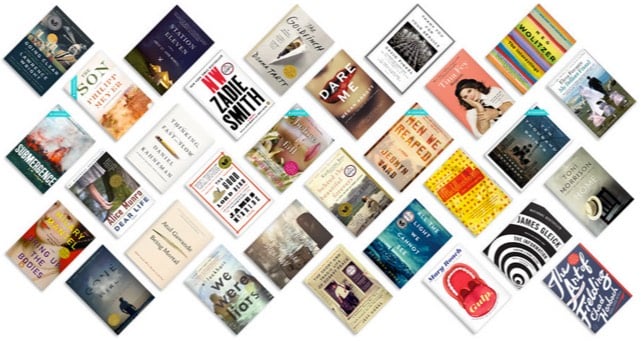
From the Oyster Review, a publication by online bookseller Oyster, a list of the 100 Best Books of the Decade So Far. Good to see The Emperor of All Maladies, Cleopatra: A Life, Bring Up the Bodies, and Mr. Penumbra’s 24-Hour Bookstore on there, among others.
Using a 1997 Lonely Planet guide to NYC in the modern day. Lots of featured businesses/attractions now closed.
True Detective season two
HBO has released a teaser trailer for season two of True Detective. Los Angeles is swapped in for Louisiana, Colin Farrell and Vince Vaughn for Woody Harrelson and Matthew McConaughey, and Justin Lin directing instead of Cary Fukunaga. It’s an entirely different show.
Here’s the synopsis from HBO:
A bizarre murder brings together three law-enforcement officers and a career criminal, each of whom must navigate a web of conspiracy and betrayal in the scorched landscapes of California. Colin Farrell is Ray Velcoro, a compromised detective in the all-industrial City of Vinci, LA County. Vince Vaughn plays Frank Semyon, a criminal and entrepreneur in danger of losing his life’s work, while his wife and closest ally (Kelly Reilly), struggles with his choices and her own. Rachel McAdams is Ani Bezzerides, a Ventura County Sheriff’s detective often at odds with the system she serves, while Taylor Kitsch plays Paul Woodrugh, a war veteran and motorcycle cop for the California Highway Patrol who discovers a crime scene which triggers an investigation involving three law enforcement groups, multiple criminal collusions, and billions of dollars.
Update: And here’s a second trailer with a little more info:
We’ve also got a premiere date: June 21.
The Apple II Watch
This is magnificent. The little floppies!
And you can totally build your own with these instructions. Case is 3D printed and the chip & software run on the Arduino platform. So cool! (via devour)
Game of Thrones pre-season briefing
From Gawker, a quick two-minute video guide to what all of the characters in Game of Thrones are up to as season five gets underway this Sunday. Major spoilers for those who aren’t caught up through the end of season four.
Apple Watch and the induced demand of communication

Some sort of embargo seems to have lifted because here come the Apple Watch reviews! As I’m unanointed by Apple, I haven’t experienced Apple Watch in the flesh, but I do have a few random thoughts and guesses.
John Gruber notes that why Apple made a watch is different from why they made the iPhone. People were generally dissatisfied with their mobile phones (I know I was) so Apple made one that was much better. But people who wear current watches like them.
But as Ive points out, this time, the established market — watches — is not despised. They not only don’t suck, they are beloved.
I’m one of the watch non-wearers Gruber discusses elsewhere in his review; I haven’t worn a watch since my Swatch band broke when I was 17. Part of the reason I don’t wear a watch is they look hideous. The more expensive watches get, the uglier they are. Have you seen the watch ads in the New Yorker or Vogue? Garish nasty looking objects. And men’s watches are generally massive, built for lumberjacks, linebackers, and other manly men, not for dainty-wristed gentlemen like myself. I tried on a regular men’s Rolex some years ago and it looked like I’d strapped a gold-plated Discman on my wrist.
I know, I know, not all watches. The point is that for me, Apple Watch looks like something I would consider wearing on a regular basis — imagining myself living in Steve Jobs’ living room has always been more my speed than J.P. Morgan’s library.1
The subtle notifications possible with Apple Watch (taps, drawings, heartbeats) are very interesting. Also from Gruber’s review:
You’re 16. You’re in school. You’re sitting in class. You have a crush on another student — you’ve fallen hard. You can’t stop thinking about them. You suspect the feelings are mutual — but you don’t know. You’re afraid to just come right out and ask, verbally — afraid of the crushing weight of potential rejection. But you both wear an Apple Watch. So you take a flyer and send a few taps. And you wait. Nothing in response. Dammit. Why are you so stupid? Whoa — a few taps are sent in return, along with a hand-drawn smiley face. You send more taps. You receive more taps back. This is it. You send your heartbeat. It is racing, thumping. Your crush sends their heartbeat back.
In 2005, I wrote about a feature I called sweethearting:
Pings would be perfect for situations when texting or a phone call is too time consuming, distracting, or takes you out of the flow of your present experience. If you call your husband on the way home from work every night and say the same thing each time, perhaps a ping would be better…you wouldn’t have to call and your husband wouldn’t have to stop what he was doing to answer the phone. You could even call it the “sweetheart ping” or “sweethearting”…in the absence of a prearranged “ping me when you’re leaving”, you could ping someone to let them know you’re thinking about them.
Like I said elsewhere in that post, this stuff always makes me think about Matt Webb’s Glancing project:
Glancing: An application to allow ultra-simple, non-verbal communication amongst groups of friends online.
It’s a desktop application that you use with a group of other people. It lets you “glance” at them in idle moments, and it gives all of you an indication of the activity of glancing going on.
A group is intended to be less than a dozen people. A person may belong to several groups simultaneously by running separate instances of Glancing. Groups are started deliberately, probably by using a www interface, and people are told the group secret so they can join (a “secret” is just a shared password).
But the thing that has struck me the most since the announcement of Apple Watch is the idea that if you’re wearing one, you’re going to be checking your devices a lot less. From TechCrunch last month:2
People that have worn the Watch say that they take their phones out of their pockets far, far less than they used to. A simple tap to reply or glance on the wrist or dictation is a massively different interaction model than pulling out an iPhone, unlocking it and being pulled into its merciless vortex of attention suck.
One user told me that they nearly “stopped” using their phone during the day; they used to have it out and now they don’t, period. That’s insane when you think about how much the blue glow of smartphone screens has dominated our social interactions over the past decade.
From Joshua Topolsky’s review at Bloomberg:
I’m in a meeting with 14 people, in mid-sentence, when I feel a tap-tap-tap on my wrist. I stop talking, tilt my head, and whip my arm aggressively into view to see the source of the agitation. A second later, the small screen on my new Apple Watch beams to life with a very important message for me: Twitter has suggestions for people I should follow. A version of this happens dozens of times throughout the day-for messages, e-mails, activity achievements, tweets, and so much more. Wait a second. Isn’t the promise of the Apple Watch to help me stay in the moment, focused on the people around me and undisturbed by the mesmerizing void of my iPhone? So why do I suddenly feel so distracted?
The promise of the Apple Watch is to make it more convenient to send & receive notifications and quick messages, although many of the reviews make it clear that Apple hasn’t entirely succeeded in this. In the entire history of the world, if you make it easier for people to do something compelling, people don’t do that thing less: they’ll do it more. If you give people more food, they eat it. If you make it easier to get credit, people will use it. If you add another two lanes to a traffic-clogged highway, you get a larger traffic-clogged highway. And if you put a device on their wrist that makes it easier to communicate with friends, guess what? They’re going to use the shit out of it, potentially way more than they ever used their phones.
Now, it’s possible that Apple Watch doesn’t make receiving notifications easier…instead, it may make controlling notifications easier. Like congestion pricing for your digital interactions. But that is generally not where technology has been taking us. Every new communications device and service — the telegraph, telephone, internet, email, personal computer, SMS, smartphones, Facebook, Whatsapp, Slack,3 etc. etc. etc. — makes it easier to 1) connect with more and more people in more and more ways, and 2) to connect with a few people more deeply. And I don’t expect Apple Watch will break that streak. The software will get faster & better, the hardware will get cheaper & longer-lasting, and people will buy & love them & use them constantly.
P.S. While I didn’t quote from it, The Verge review is great. But mainly I’m wondering…where are the reviews from the fashion world? I assume Vogue and other such magazines and media outlets received Apple Watches for review and their embargoes lifted as well, but after searching for a bit, I couldn’t find any actual reviews. And only a single major review by a woman, Lauren Goode’s at Re/code. If you run across any, let me know?
Update: Joanna Stern wrote a review for the WSJ with an emphasis on the fashion aspect. (via @trickartt)
Update: Executive editor Nicole Phelps wrote a review for style.com. (thx, louis-olivier)
Have you been to the Morgan Library? It’s great, a lesser known gem of a museum in Manhattan. I went this past weekend, in fact. But I would not like to live in such a baroque place.↩
God, I hate linking to TechCrunch — I’ve only linked to them a handful of times and I complain about it every time — but they were the best source for this point. Apologies to my soul.↩
The conventional wisdom about Slack is that it’s rescuing us from the tyranny of email. But when everyone is on Slack because it’s easier and offers certain advantages over email, then what? What will rescue us from the tyranny of Slack? (A: Nothing. That’s the point…we can’t help wanting to communicate in easier ways with our fellow humans, so much so that we gorge ourselves like geese at the gavage. Whatever kills Slack will be a bigger, easier communications gavage. Rinse. Repeat. Until the heat death of the Universe.) ↩
Are you working at a start-up or are you in jail? “Are you dressed the same as everyone else?”
Modern day VHS

Someone pretending to be a Parisian hipster who only watches VHS versions of modern shows & movies like Game of Thrones and Interstellar created these VHS covers as an April Fools joke. These are actually pretty great. (via subtraction)
Haas Unica rides again

Conceived in the late 1970s as a hybrid of three of the most popular (and some would say, overused) sans-serif typefaces in the world, Haas Unica didn’t make the digital jump to personal computers in the 1980s. It was nearly forgotten, but has been revived by Monotype, which released Neue Haas Unica as a webfont today.
Unica® was an attempt to create the ultimate sans-serif - a hybrid of Helvetica, Univers and Akzidenz Grotesk. Designed by Team ‘77 and released to great acclaim in 1980, Unica went missing under a heap of legal disputes and has never been available as a full, digital typeface. Until now.
Unica’s story starts in the 1970s. Electronic, on-screen phototypesetting was gaining popularity, but most sans-serif typefaces on the market had been designed earlier, in the era of metal type. The revered Haas Type Foundry in Münchenstein, Switzerland, saw the chance to develop a new sans-serif face that was optimized for the new technology and filled the gap in the market. To develop their new product, they turned to Swiss type design trio, Team ‘77 (André Gürtler, Christian Mengelt and Erich Gschwind).
Team ‘77 set out to design a font based on Helvetica but drawing on other sans-serif typefaces, principally Univers. The name they gave it would also be a hybrid of the two.
The original name for Helvetica was Neue Haas Grotesk. Haas + Univers + Helvetica = Haas Unica.
Update: Several digital versions of Haas Unica have been available prior to this one.
For many years a digital version of Unica was available from Scangraphic (and Elsner+Flake) but it was pulled from the market due to a complaint by Linotype who claims the Haas rights. In 2008, Cornel Windlin did a Semibold for the the Schauspielhaus Zürich identity, used in 2009-10. Later, Louise Paradis created a revival named Unica Intermediate while doing research for the TM retrospective.
(via @typographica)
The rail refresher
Meet the enormous machine that refreshes railroad tracks (rails, ties, gravel) with minimal human involvement. Fun to see the infrastructure behind the infrastructure.
Not even John Henry would stand a chance against this behemoth.
Philip Glass wrote a memoir, Words Without Music. Just came out yesterday.
From an analytical chemist: The “Food Babe” Blogger Is Full of Shit
The Brontosaurus is back, baby!

After years of the Flintstones lying to me, I’d just gotten used to the idea of the Brontosaurus not actually being a dinosaur. But a recent study of the classifications given to various species and genera within the diplodocid group of dinosaurs has determined that the Brontosaurus and the Apatosaurus are different enough to be two separate species.
Very broadly, their tree confirmed established ideas about the evolutionary relationships among diplodocids. But the scientists also concluded that Apatosaurus and Brontosaurus were different enough to belong in their own genera. Many of the anatomical differences between the two dinosaurs are obscure, Tschopp says, but Apatosaurus’s stouter neck is an obvious one. “Even though both are very robust and massive animals, Apatosaurus is even more so,” he adds.
Tschopp and his team thought very carefully about their decision to reinstate Brontosaurus, and they expect some pushback. “We knew it would be a major finding because Brontosaurus is such a popular name,” he says. “I’m pretty sure there will be a scientific discussion around this. I hope there will be. That’s how science works.”
Huzzah! Now reinstate Pluto to full planetary status and we’ll be all set. See also The Kindly Brontosaurus. (via @coudal)
John Oliver interviews Edward Snowden
Last night on Last Week Tonight, John Oliver took on the topic of government surveillance and traveled to Moscow to interview Edward Snowden. After some softball questions — “Do you miss Hot Pockets?” — Oliver presses Snowden on his personal responsibility with regard to the information he revealed.
Coloring books for adults
The two top-selling books on Amazon right now are a pair of coloring books for adults by Johanna Basford: Enchanted Forest and Secret Garden.

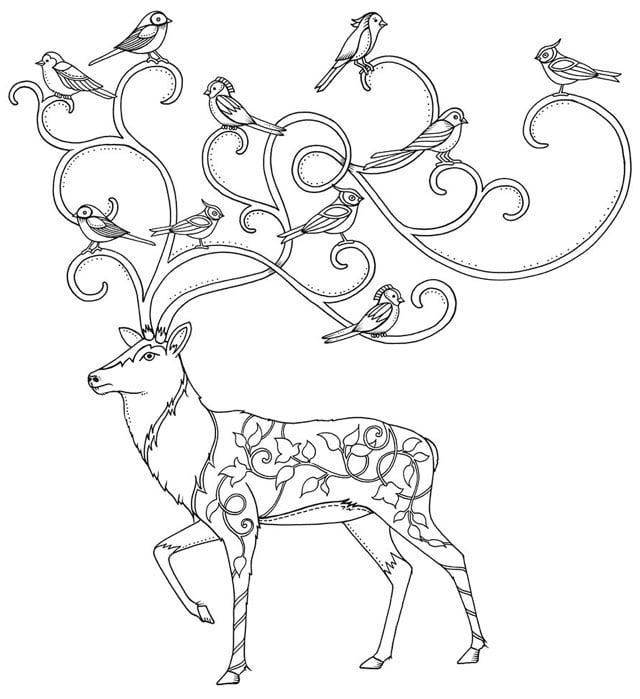

Fans of the books have been posting examples of their coloring-in online; this one is from occasionalartist:

What This Says™ about contemporary culture is left as an exercise to the reader. Right after you finish coloring your flowers, of course.
Update: I recently discovered that a pal of mine, Souris Hong, did a coloring book for adults a couple of years ago called Outside the Lines.
For anyone who loves creativity and contemporary art, or who simply loves the joy of coloring, comes Outside the Lines, a striking collection of illustrations from more than 100 creative masterminds, including animators, cartoonists, fine artists, graphic artists, illustrators, musicians, outsider artists, photographers, street artists, and video game artists. With contributions from Keith Haring, AIKO, Shepard Fairey, Exene Cervenka, Keita Takahashi, Jen Corace, Ryan McGinness, and more, Outside the Lines features edgy and imaginative pieces ready for you to add your own special touch.
And there’s going to be a sequel out in September.
Bracket for the worst things on the Internet
From Jon Bois at SBNation, The Worst Internet Things bracket. Some of the worst things and their seedings include:
(16) Person who types “wow” in front of retweet
(9) Atheists who love to argue
(7) All internet discourse about bacon
(8) People who complain about BuzzFeed
(2) iTunes
(5) Kickstarters for weddings
The beautiful thinking game
Judging by interviews, neither Wayne Rooney or Lionel Messi seems like the smartest tool in the shed, but they both possess a keen mind for football as Simon Kuper explains. Messi, who appears to listlessly sandbag his way through the early part of matches, is actually using the time to size up his opponent:
It was a puzzling sight. The little man was wandering around, apparently ignoring the ball. The official explained: “In the first few minutes he just walks across the field. He is looking at each opponent, where the guy positions himself, and how their defense fits together. Only after doing that does he start to play.”
And Rooney uses visualization (or as Shaq would call it, dreamful attraction), just like Allen Iverson:
“Part of my preparation,” he told the writer David Winner for ESPN The Magazine in 2012, “is I go and ask the kit man what colour we’re wearing, if it’s red top, white shorts, white socks or black socks. Then I lie in bed the night before the game and visualize myself scoring goals or doing well. You’re trying to put yourself in that moment and trying to prepare yourself, to have a ‘memory’ before the game. I don’t know if you’d call it visualizing or dreaming but I’ve always done it, my whole life.”
A footballer’s exceptional visual memory was on display recently when FC Barcelona’s Xavi Hernandez was quizzed about 5 particular goals he’s scored out of 57 total across almost 500 matches for his club:
He gets them all correct, even what the scores were when they happened, the final scores, who else scored in each match, and even the team’s position in La Liga.
A quick P.S. for Messi. On Feb 16, 2015, Zito Madu wrote an article titled Is Lionel Messi even good anymore?
Plainly put, Messi is a shadow of his former self. He’s much more cynical, more selfish and power-hungry. How else can the departure of Martino and friction with Enrique be explained? It’s a power play by a man who feels his powers waning. Consider: after Barcelona’s 5-0 victory against Levante, Messi had only managed 37 goals and 18 assists in all competitions. A far cry from the player who once scored 82 goals in one season.
At 27 years old, we might be witnessing the twilight of Messi’s career. It’s a shame for a player who seemed to be on a tear just a few years ago.
It was a weirdly cynical take that contained a kernel of truth. A little over a month later on Mar 23, Jeff Himmelman wrote a piece called Lionel Messi Is Back On His Game.
But in the new year, Messi has finally started to look like himself again; he has been on fire, racking up hat tricks and leading the league in scoring. His legs and his extraordinary bursts of energy — the engine of his game — are back, and a move to the right flank from the congested middle has freed him to do what he does best: making slashing runs at defenders with speed, creating space and chances.
On the evidence of the last week, it has become possible to wonder whether Messi might actually be better than ever. The best reason to think so was the first half of Barcelona’s game against Manchester City on Wednesday, in the round of 16 of the Champions League European club championships. From the start, Messi spun passes into tight spaces and flew up and down the field with a boyish abandon that was nowhere to be found last year.
In that Man City game, Messi nutmegged both Milner and Fernandinho:
In a recent study released by CIES Football Observatory, Messi was judged to be the best forward in the world over the first three months of 2015. Ronaldo? 29th place. Eep.
Update: Real Madrid keeper Iker Casillas demonstrates his remarkable memory, recalling scores from matches from up to 15 years ago he didn’t even play in. (via @adamcohen15)
Meanwhile, back at the ranch…
For the one-year anniversary of Every Frame a Painting, Tony Zhou goes meta and talks about how to structure a video essay, using South Park and Orson Welles’ F for Fake.
Happy anniversary EFAP!
The US Forest Service’s Cocktail Construction Chart

This is…weird. The National Archives contains a Cocktail Construction Chart made in an architectural style, for some reason, by the US Forest Service in 1974.
Update: Kenny Herzog at Esquire did some digging and found out some of the chart’s backstory.
If it does, royalties might be due to the family of late Forest Service Region 8 Engineer Cleve “Red” Ketcham, who passed away in 2005 but has since been commemorated in the National Museum of Forest Service History. It’s Ketcham’s signature scribbled in the center of the chart, and according to Sharon Phillips, a longtime Program Management Analyst for Region 8 (which covers Virginia, Georgia, Florida, Oklahoma and Puerto Rico, though Ketcham worked out of its Atlanta office), who conferred with her engineering department, there’s little doubt Ketcham concocted the chart in question. “They’re assuming he’s the one, because the drawing has a date of 1974, and he was working our office from 1974-1980,” she said. And in case there’d be any curiosity as to whether someone else composed the chart and Ketcham merely signed off on it for disbursement, Phillips clarified that, “He’s the author of the chart. I wouldn’t say he passed it along to the staff, because at that time, he probably did that as maybe a joke, something he did for fun. It probably got mixed up with some legitimate stuff and ended up in the Archives.”
I contacted the librarian at the Forest History Society and found similar information. An archivist pulled a staff directory from the Atlanta office (aka “Region 8”) from 1975 and found three names that correlate with those on the document: David E. Ketcham & Cleve C. Ketcham (but not Ketchum, as on the document) and Robert B. Johns (presumably aka the Bob Johns in the lower right hand corner). Not sure if the two Ketchams were related or why the spellings of Cleve’s actual last name and the last name of the signature on the chart are different.
However, in the past few days, I’ve run across several similar charts, most notably The Engineer’s Guide to Drinks.1 Information on this chart is difficult to come by, but various commenters at Flowing Data and elsewhere remember the chart being used in the 1970s by a company called Calcomp to demonstrate their pen plotter.
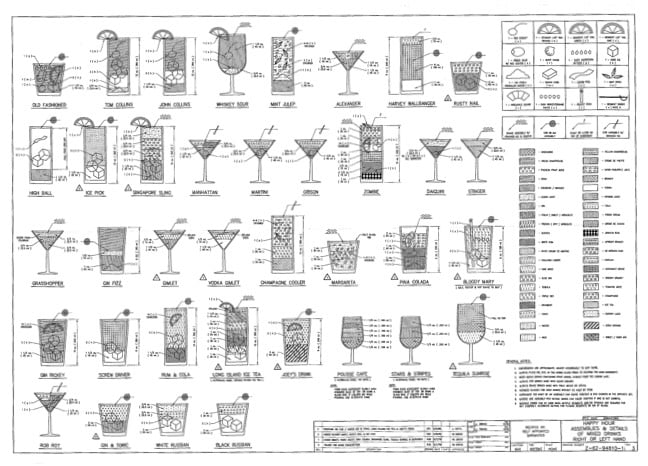
As you can see, the Forest Service document and this one share a very similar visual language — for instance, the five drops for Angostura bitters, the three-leaf mint sprig, and the lemon peel. And I haven’t checked every single one, but the shading employed for the liquids appear to match exactly.
So which chart came first? The Forest Service chart has a date of 1974 and The Engineer’s Guide to Drinks is dated 1978. But in this post, Autodesk Technologist Shaan Hurley says the Engineer’s Guide dates to 1972. I emailed Hurley to ask about the date, but he couldn’t point to a definite source, which is not uncommon when you’re dealing with this sort of thing. It’s like finding some initials next to “85” scratched into the cement on a sidewalk: you’re pretty sure that someone did that in 1985 but you’d have a tough time proving it.
FWIW, if I had to guess where this chart originated, I’d say that the Calcomp plotter demo got out there somehow (maybe at a trade show or published in an industry magazine) and every engineer took a crack at their own version, like an early internet meme. Cleve Ketcham drew his by hand while others probably used the CAD software running on their workplace mainframes or minicomputers.
Anyway, if anyone has any further information about where these CAD-style cocktail instructions originated, let me know. (thx, @john_overholt & tre)
Other instances include these reprints of drawings from 1978 on eBay and an advertisement for a Cocktail Construction drawing in the Dec 1982 issue of Texas Monthly. ↩
The sounds of Hollywood
A profile of Gregg Barbanell, who is a Hollywood Foley artist responsible for the ambient sounds (walking, clothes rustling, gunshots, etc.) in Breaking Bad, Little Miss Sunshine, and The Walking Dead. The best bits are about how specific sounds are made.
Popular apocalyptic zombie TV series The Walking Dead has no shortage of gore — and as the show’s Foley artist, Barbanell is tasked with creating most of its gruesome “blood and guts” sounds. “They’re pulling organs out of bodies, they’re slicing heads off, reaching into bodies, pulling out things,” says Barbanell, with disgust. “So, we get creative.”
For “gushy, squishy sounds” like oozing blood, Barbanell uses chamois (a leather cloth made from the skin of mountain sheep). “You soak it, then lay into it, and it just oozes — it’s something you can control really easily,” he says. “And when you put pressure on it, you get these amazing, gory noises.” Sometimes, when that extra oompf is needed, he’ll go out and buy a whole, raw chicken to stuff the chamois inside of.
For “breaking bones,” big, full stocks of celery are employed — not merely individual stocks, mind you, but HUGE bunches capable of producing layered, complex snaps. “They give you this huge, sinewy stringy sound,” adds Barbanell. “It’s very effective.”
Oh, and his collection of shoes for making different walking sounds, some of which are shown here:
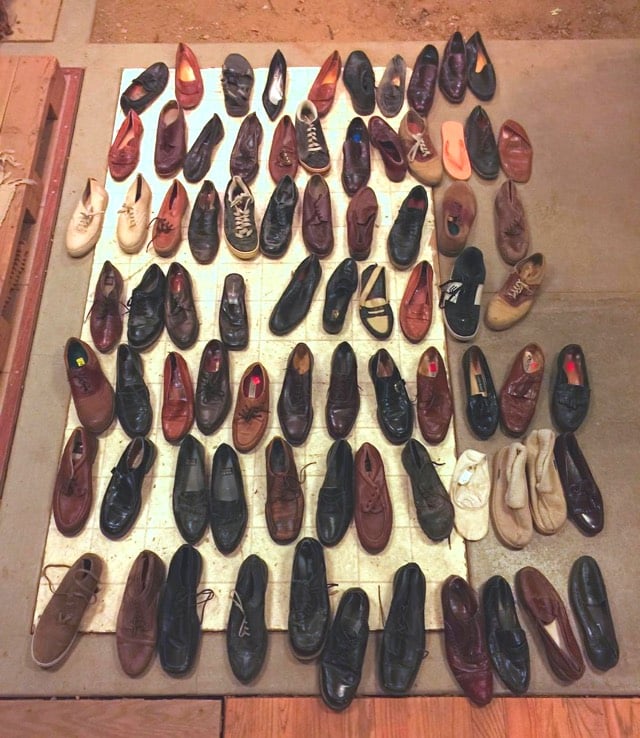
I love that Foley is still something done by hand, but sometimes it’s a bit too much, less like ambient noise and more like these exaggerated Wordless Musicvideos.
The Enigma wristwatch

Forget the Pebble or Apple Watch. Wouldn’t you rather wear a fully functional three-rotor Engima machine wristwatch?
The idea here wasn’t to make the smallest one possible. I decided to make a device that was practical and useable. And something that looks like it was from WW2. Something that could actually be used in the field in place of a real Enigma machine. Obviously there were some limitations. I could have a 26 key keyboard for a start so I had to come up with a UI that would work with a minimal number of keys. I bought a small 128x64 OLED, a suitable battery and started breadboarding it all up. With it working on a normal Arduino I bought an Arduino Pro Mini (or a good replica!) and started looking at getting it running on that.
For reference, here’s what an actual Enigma machine looks and how it works.
Middle aged molly
Mary H.K. Choi writes about reconnecting with an experience she’d had when she was younger: rolling on molly.
When you’re a kid, you think you’ll be a certain place in your mid-30s. I presumed I’d be rich because when you’re middle-class with hardworking immigrant parents that’s the whole point. I also thought I’d be married and potentially own a beautiful apartment in New York. Ha ha. What you spend zero time wondering about is whether you’ll still be doing drugs. You naturally assume you’ll grow out of whatever stupidity you dabbled in as a teen. Even up to my 20s I didn’t realize that job-having, non-fuckup grown-ups in their 30s and 40s still smoked weed. Or did ecstasy.
But then I got older and got bored. Saying you’re bored as an adult is truly despicable since it implies that your Maslow’s pyramid is so satisfied, so abundant with shelter, food, health, and love, that you’re driven to idly wishing you liked video games more.
What I want is a vacation from myself. I’ve tried exercise, meditation, sex, and food. I wait for the desire to plan a wedding or have a kid or buy a house and when those things don’t take hold or are plainly untenable, I get my aura read. I open a trillion tabs of internet and drink it in. I gorge on studies about magnets that make you think differently and begin researching the properties of crystals. I don’t think about any of it as self-help because that’s way too pathetic, certainly more than the itchy meh I feel. I want to hurl my brain into outer space; it’s real, real quiet there, the ultimate holiday of feeling small. But because I’m not pregnant and don’t have cancer, I just want to do drugs again.
Guillaume Cornet’s dense city illustrations
I love Guillaume Cornet’s fanciful and intricate drawings. He’s done Paris, New York, and a London apartment building, among others.


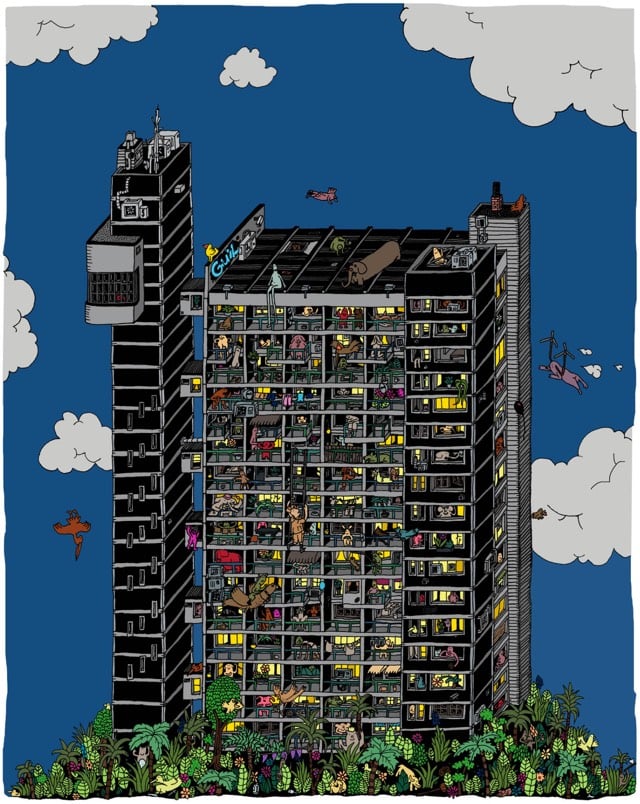
Society6 recently put a camera on Cornet while he did his Paris drawing, condensing 75 hours of painstaking work into a 2-minute time lapse.
My favorite little detail highlighted by Society6 is the appearance of the Emmet minifig in the NYC illustration, complete with the Piece of Resistance.
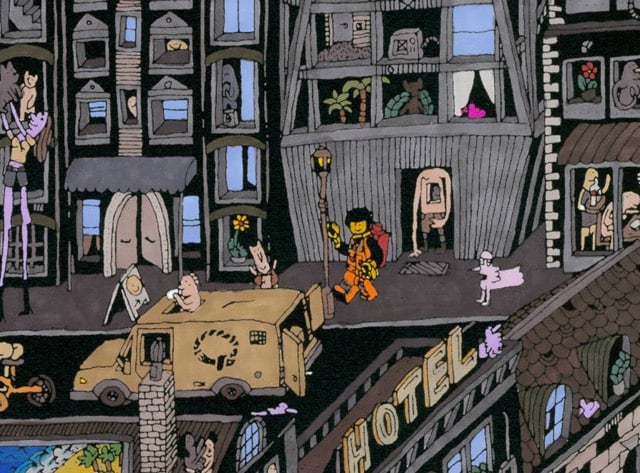





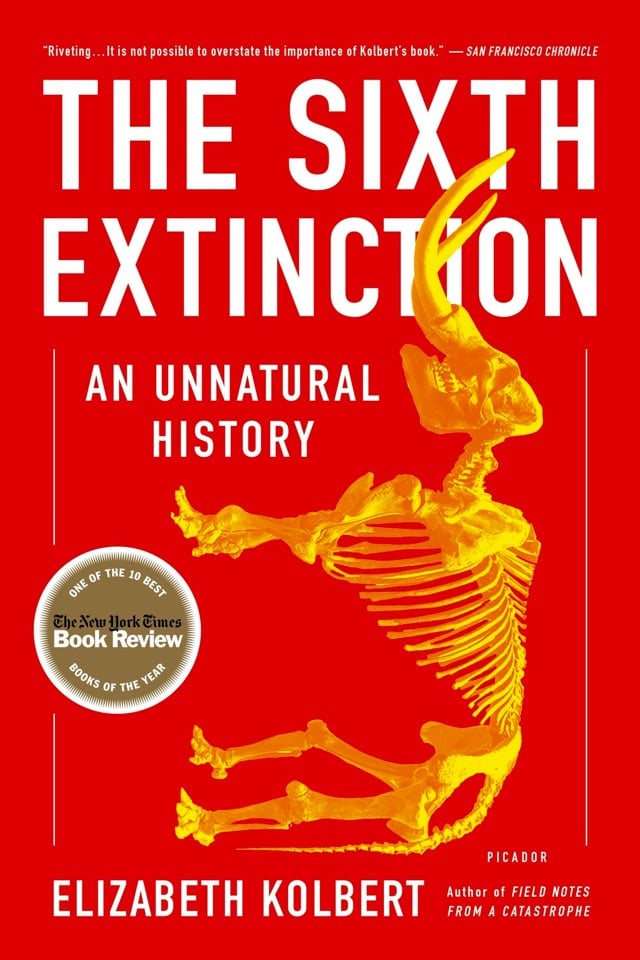


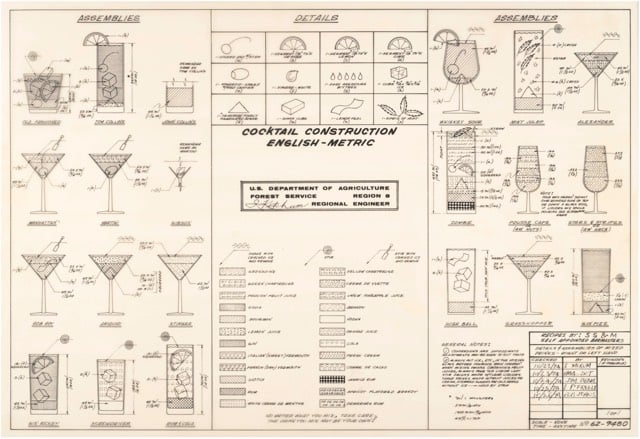
Stay Connected